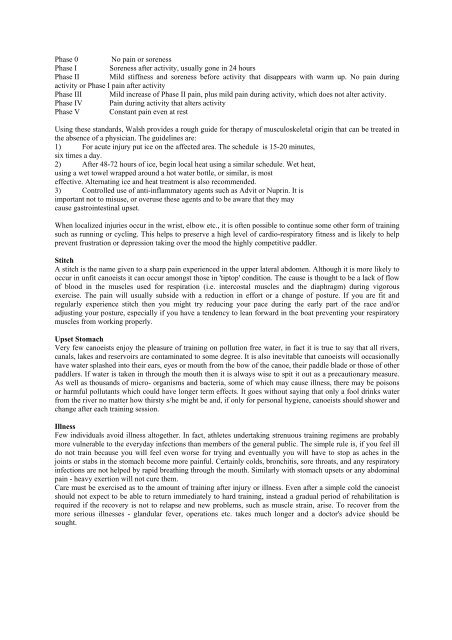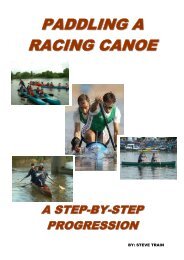The Science of Canoeing By Richard Cox
The Science of Canoeing By Richard Cox
The Science of Canoeing By Richard Cox
You also want an ePaper? Increase the reach of your titles
YUMPU automatically turns print PDFs into web optimized ePapers that Google loves.
Phase 0 No pain or soreness<br />
Phase I Soreness after activity, usually gone in 24 hours<br />
Phase II Mild stiffness and soreness before activity that disappears with warm up. No pain during<br />
activity or Phase I pain after activity<br />
Phase III Mild increase <strong>of</strong> Phase II pain, plus mild pain during activity, which does not alter activity.<br />
Phase IV Pain during activity that alters activity<br />
Phase V Constant pain even at rest<br />
Using these standards, Walsh provides a rough guide for therapy <strong>of</strong> musculoskeletal origin that can be treated in<br />
the absence <strong>of</strong> a physician. <strong>The</strong> guidelines are:<br />
1) For acute injury put ice on the affected area. <strong>The</strong> schedule is 15-20 minutes,<br />
six times a day.<br />
2) After 48-72 hours <strong>of</strong> ice, begin local heat using a similar schedule. Wet heat,<br />
using a wet towel wrapped around a hot water bottle, or similar, is most<br />
effective. Alternating ice and heat treatment is also recommended.<br />
3) Controlled use <strong>of</strong> anti-inflammatory agents such as Advit or Nuprin. It is<br />
important not to misuse, or overuse these agents and to be aware that they may<br />
cause gastrointestinal upset.<br />
When localized injuries occur in the wrist, elbow etc., it is <strong>of</strong>ten possible to continue some other form <strong>of</strong> training<br />
such as running or cycling. This helps to preserve a high level <strong>of</strong> cardio-respiratory fitness and is likely to help<br />
prevent frustration or depression taking over the mood the highly competitive paddler.<br />
Stitch<br />
A stitch is the name given to a sharp pain experienced in the upper lateral abdomen. Although it is more likely to<br />
occur in unfit canoeists it can occur amongst those in 'tiptop' condition. <strong>The</strong> cause is thought to be a lack <strong>of</strong> flow<br />
<strong>of</strong> blood in the muscles used for respiration (i.e. intercostal muscles and the diaphragm) during vigorous<br />
exercise. <strong>The</strong> pain will usually subside with a reduction in effort or a change <strong>of</strong> posture. If you are fit and<br />
regularly experience stitch then you might try reducing your pace during the early part <strong>of</strong> the race and/or<br />
adjusting your posture, especially if you have a tendency to lean forward in the boat preventing your respiratory<br />
muscles from working properly.<br />
Upset Stomach<br />
Very few canoeists enjoy the pleasure <strong>of</strong> training on pollution free water, in fact it is true to say that all rivers,<br />
canals, lakes and reservoirs are contaminated to some degree. It is also inevitable that canoeists will occasionally<br />
have water splashed into their ears, eyes or mouth from the bow <strong>of</strong> the canoe, their paddle blade or those <strong>of</strong> other<br />
paddlers. If water is taken in through the mouth then it is always wise to spit it out as a precautionary measure.<br />
As well as thousands <strong>of</strong> micro- organisms and bacteria, some <strong>of</strong> which may cause illness, there may be poisons<br />
or harmful pollutants which could have longer term effects. It goes without saying that only a fool drinks water<br />
from the river no matter how thirsty s/he might be and, if only for personal hygiene, canoeists should shower and<br />
change after each training session.<br />
Illness<br />
Few individuals avoid illness altogether. In fact, athletes undertaking strenuous training regimens are probably<br />
more vulnerable to the everyday infections than members <strong>of</strong> the general public. <strong>The</strong> simple rule is, if you feel ill<br />
do not train because you will feel even worse for trying and eventually you will have to stop as aches in the<br />
joints or stabs in the stomach become more painful. Certainly colds, bronchitis, sore throats, and any respiratory<br />
infections are not helped by rapid breathing through the mouth. Similarly with stomach upsets or any abdominal<br />
pain - heavy exertion will not cure them.<br />
Care must be exercised as to the amount <strong>of</strong> training after injury or illness. Even after a simple cold the canoeist<br />
should not expect to be able to return immediately to hard training, instead a gradual period <strong>of</strong> rehabilitation is<br />
required if the recovery is not to relapse and new problems, such as muscle strain, arise. To recover from the<br />
more serious illnesses - glandular fever, operations etc. takes much longer and a doctor's advice should be<br />
sought.



